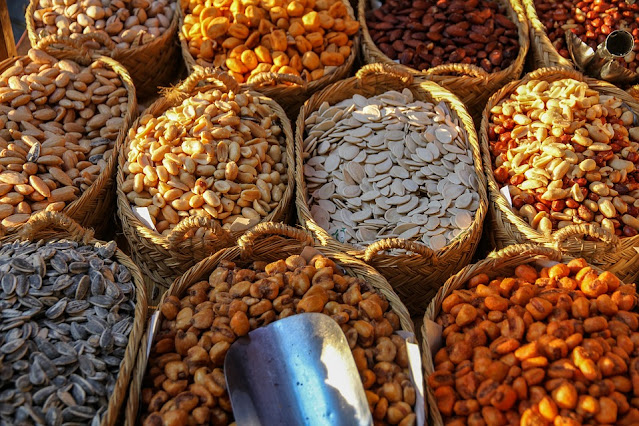Baking Soda vs. Baking Powder: Spot the Fizzy Difference!
When it comes to baking or cooking, two ingredients often found in recipes are baking soda and baking powder. While they might look similar and serve similar purposes, they are quite different in composition, function, and use. Understanding these differences is essential, especially in Indian kitchens, where diverse recipes demand precise ingredients for the perfect results.
 |
| Image Courtesy- Pixabay |
What is Baking Soda?
A pure chemical compound, baking
soda, is scientifically called sodium bicarbonate. It is a strong alkaline
substance that reacts with acidic ingredients to produce carbon dioxide gas,
causing batters and dough to rise. However, it needs an acid to activate its
leavening properties. Common acidic ingredients include lemon juice, curd,
vinegar, buttermilk, or even jaggery.
Usage in Indian Kitchens: Baking
soda is often used in recipes like idlis, dhoklas, or pakoras to create a
fluffy texture. For instance, adding a pinch of baking soda to dhokla batter
helps it rise and results in soft, spongy cakes. Similarly, baking soda is used
in fried items like bhaturas or jalebis for a light and airy texture.
Caution: Since baking soda is
highly alkaline, using too much can leave a soapy or bitter taste in your food.
Always measure carefully.
What is Baking Powder?
Baking powder, on the other hand,
is a mixture of baking soda, an acid (like cream of tartar), and a drying agent
(like cornstarch). Unlike baking soda, baking powder is a complete leavening
agent and does not require an additional acid to work. It usually contains two
types of acids: one that reacts immediately when mixed with wet ingredients and
another that activates when exposed to heat (double-acting).
Usage in Indian Kitchens: Baking
powder is widely used in baked goods like cakes, muffins, and cookies to make
them light and fluffy. In Indian kitchens, it is also used for desserts like
nankhatai, eggless cakes, or biscuits. It is more stable than baking soda,
making it a go-to choice for recipes that don't have an acidic component.
Caution: Excessive baking powder can also result in a metallic taste, so stick to the measurements specified in recipes.
What is the difference between baking soda and baking powder?
The key differences between
baking soda and baking powder lie in their composition, reaction process,
taste, and usage. Baking soda is pure sodium bicarbonate, while baking powder
is a combination of baking soda, an acid, and a drying agent. Baking soda requires
an acidic ingredient to activate and release carbon dioxide, whereas baking
powder is self-activating due to the acid it already contains. In terms of
taste, overusing baking soda can result in a bitter flavor, while baking powder
is less likely to significantly alter the taste of a recipe. As for usage,
baking soda works best in recipes with acidic ingredients, while baking powder
is suitable for recipes that lack acids.
How to Use Baking Soda & Baking Powder Both Together
Some recipes, especially baked
goods, call for both baking soda and baking powder. This is because baking soda
provides a quick rise by reacting with acidic ingredients, while baking powder
ensures a slow, steady rise during cooking or baking. For example, in
Indian-style eggless cakes, a combination of curd (acid), baking soda, and
baking powder often works wonders to achieve the right fluffin
How to use baking soda & baking powder in Indian Kitchens:
Freshness Matters: Baking soda
and powder lose their potency over time. Always check the expiration date and
store them in airtight containers.
Substitution: If a recipe calls
for baking powder and you only have baking soda, you can make your own baking
powder by mixing 1 part baking soda with 2 parts cream of tartar and 1 part
cornstarch.
Balance Flavors: When using
baking soda in recipes with jaggery or buttermilk, ensure the ratio is correct
to avoid overpowering the dish with bitterness.
Experiment: For items like
kulchas or malai cakes, try small amounts of baking powder for a balanced rise.
Finally, while baking soda and baking powder might look similar, their uses and properties differ significantly. Knowing when and how to use each can make a world of difference in achieving culinary perfection in Indian dishes.





In baking, the distinctions between the two are quite important. A strong, instant rise is produced by baking soda, which needs to be counterbalanced by acidic components. In contrast, baking powder is more dependable and practical for recipes that don't call for acidic ingredients. maryland prostitution laws
ReplyDeleteAlthough they are employed as leavening agents in baking, baking powder, and baking soda function differently, baking powder has both an acid and a base, whereas baking soda needs an acid to activate. Knowing these specifics can help with effective communication when it comes to assignments like Write My CIPD Assignment for Me.
ReplyDeleteYour Trusted Health Insurance policy Partner in Tamil Nadu We're experienced health insurance agency offering comprehensive solutions.
ReplyDeleteStarting a business requires multiple registrations for compliance. From GST Registration in Chennai to LLP Registration, ShopLegal ensures a smooth process. Also consider Trademark Registration and ISO Certification to protect your business.
ReplyDelete